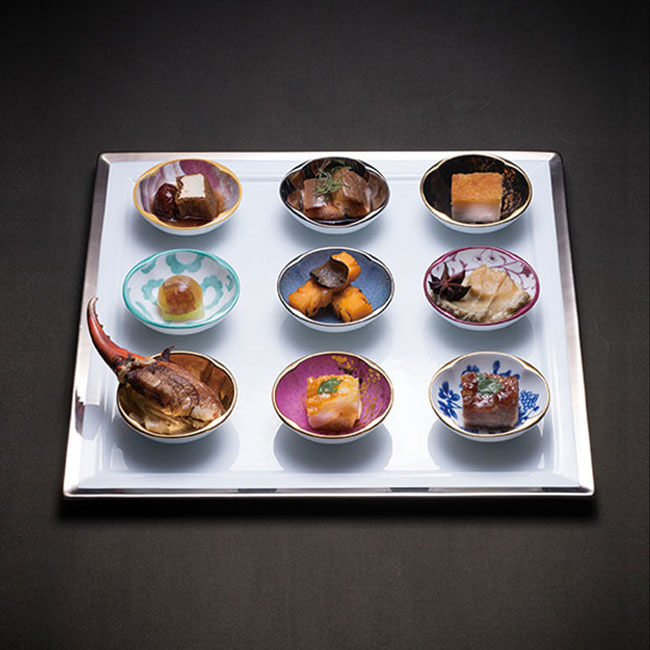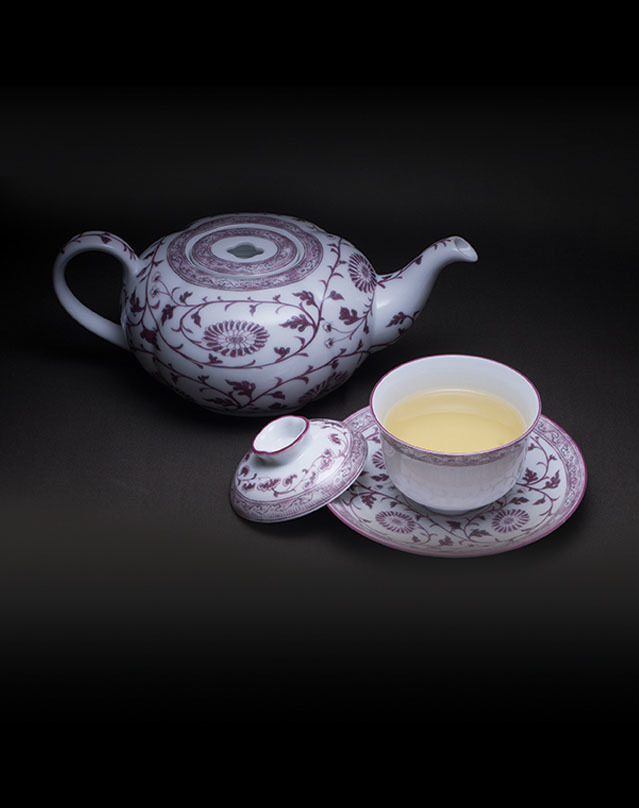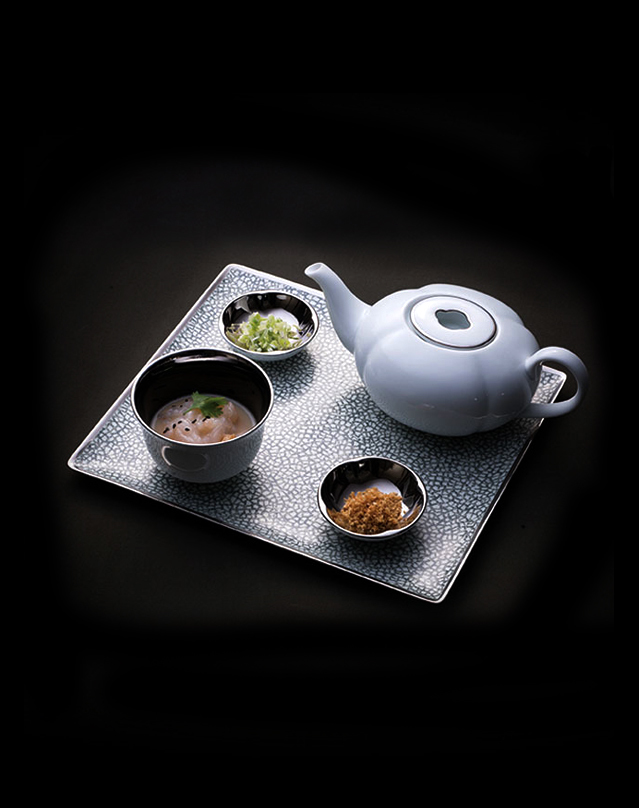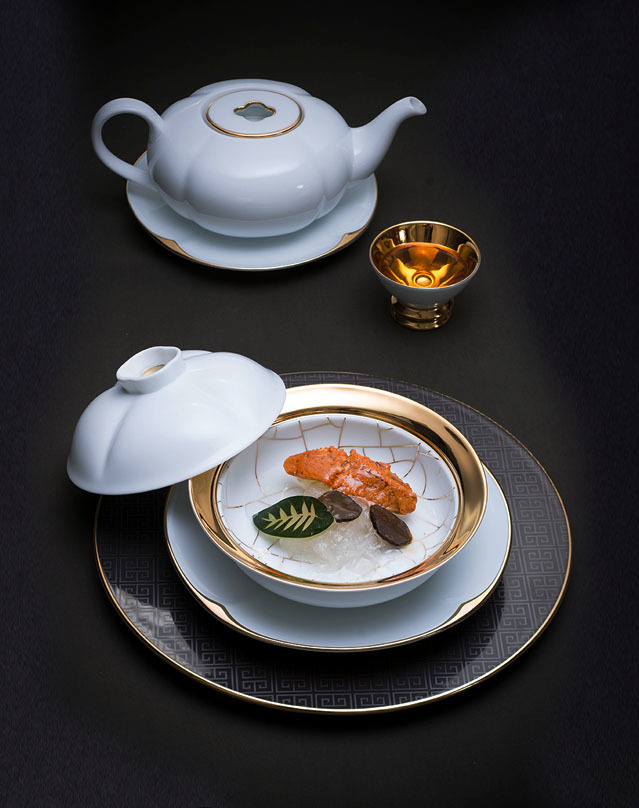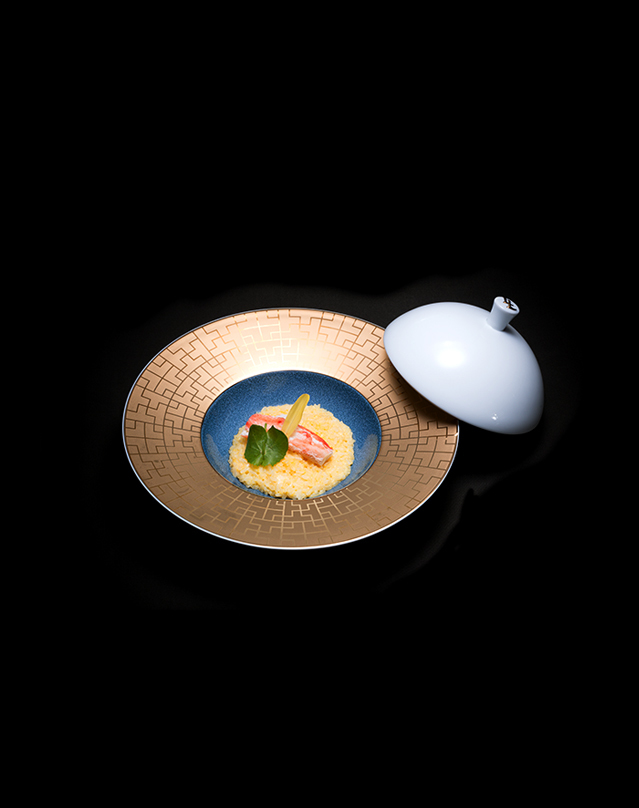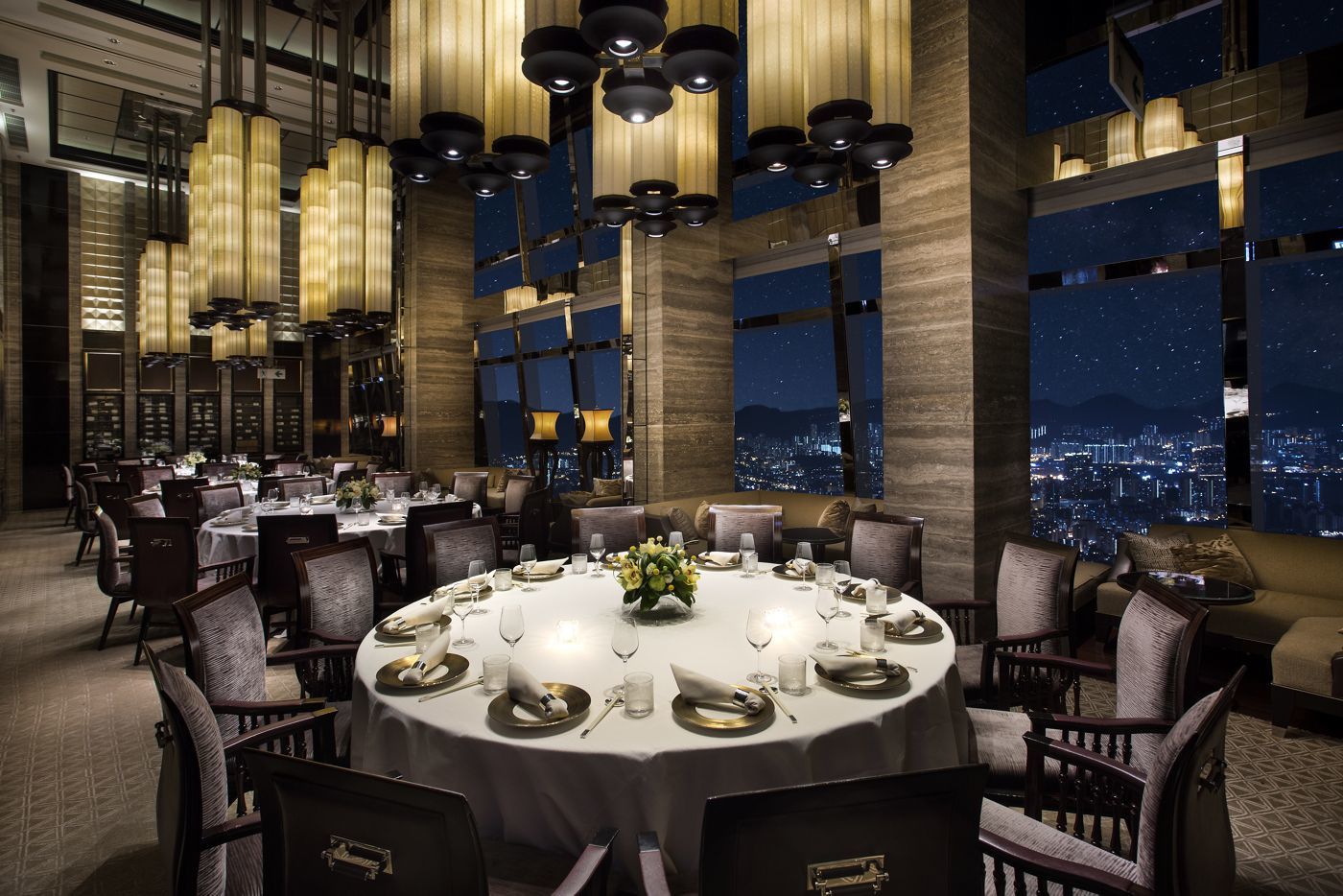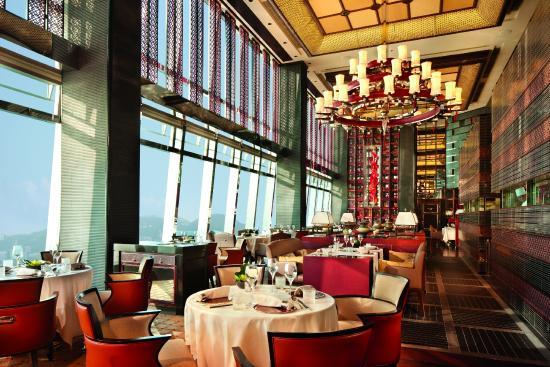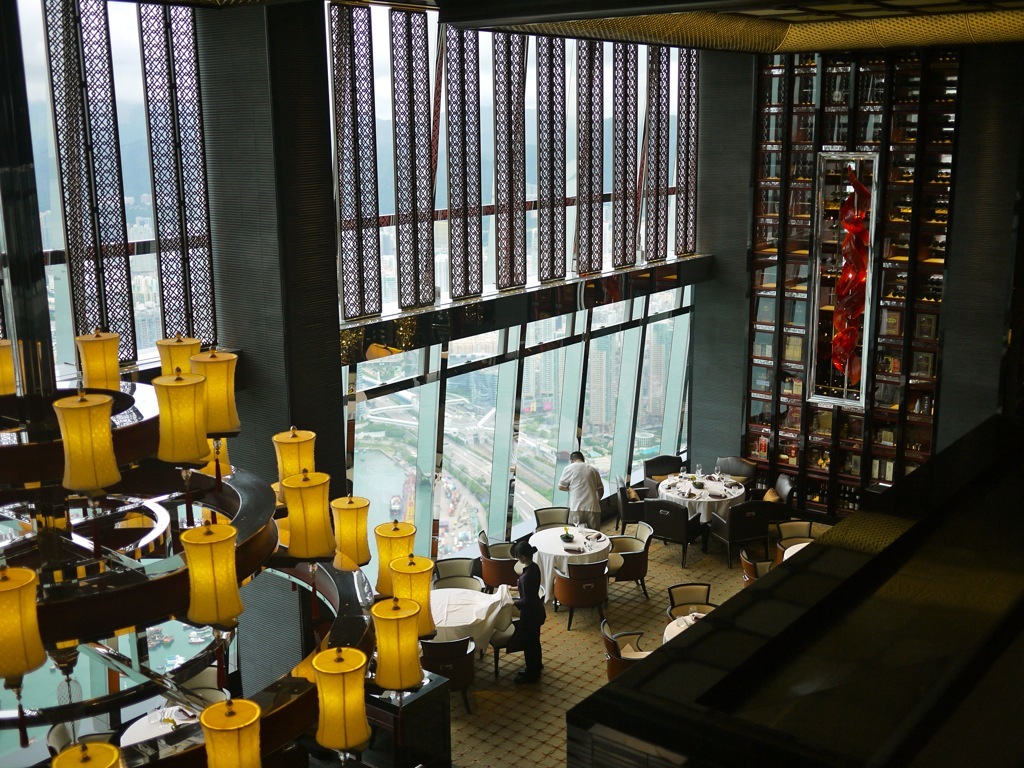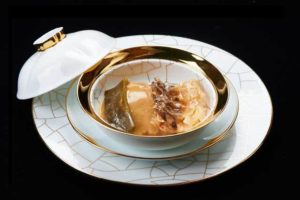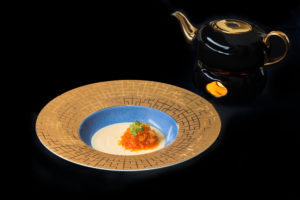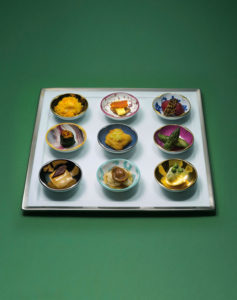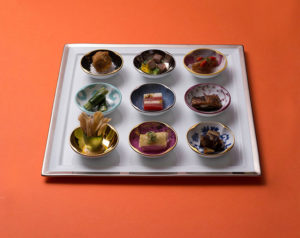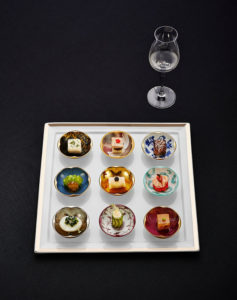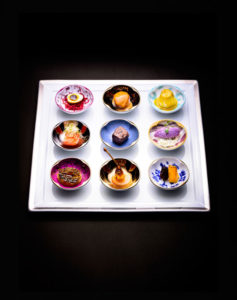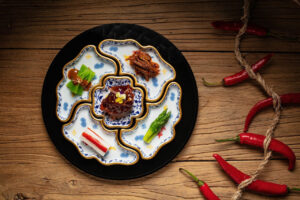

Tin Lung Heen restaurant / Hong Kong
Located on the 102nd floor with a spectacular bird’s eye view of the Hong Kong skyline, Tin Lung Heen adorned with two Michelin stars is the ultimate dining venue.
With over 30 years of culinary experience and highly regarded as one of the top Cantonese chefs in Hong Kong, Chef Paul Lau Ping Lui demonstrated his master skills in Cantonese cooking in this gourmet showcase.
A keen believer in culinary innovation, Chef Lau is passionate about establishing Cantonese cuisine on the international dining scene.
Using premium ingredients hand-picked from around the world combined with traditional Cantonese cooking techniques, Chef Lau collaborates with premium Chinaware LEGLE Porcelain to introduce the ‘RUYI Menu’.
Encompassing China’s 5,000 years of culinary history, food aficionados can expect an exuberant feast for all senses.
Harmonious Jiu Gong Ge Appertizer paired with bamboo leaf green tea
Each delectable delicacy is meticulously placed on a dish of contrasting color chosen for stark visual effects.
The vibrant colors of the dishes represent different periods in China’s history of fine porcelain-red from Yuan Dynasty and cobalt blue from Ming Dynasty and more…The mesmerizing palette of colors transforms the nine dishes into an unforgettable fine art painting.
A popular professional tea drinking utensil during Ming and Qing Dynasties
Originated in the Tang Dynasty, the Gaiwan became popular during the Qing Dynasty and widely used in the imperial palace and amongst the nobility. This ingenious vessel signifies a major innovation in tea rituals and how teas are infused.
Consistiong of a lid, bowl and saucer to denote heaven, man and earth, it is a symbol of harmony and of being one with the universe. The lustre and purity of finely glazed porcelain enables the colour, taste, aroma and essence of tea to be released and enjoyed in its most natural and authentic form. The Late Yuan & early Ming under glazed red: This technique for decorating porcelain ware was invented in Yuan Dynasty.
Translucent white contrasting with under glazed red evokes purity with a fresh elegance.
The original technique of how to produce this type of glaze has long since disappeared but the artisans at LEGLE Porcelain have managed to replicate the technique and bring back its former glory in this Gaiwan.
RUYI lobster bisque
Slowly simmered for 4 hours, this aromatic lobster bisque captures the finest essence of Chinese and Western cooking styles.
Fresh thinly sliced local lobster is placed in a bowl like fine pieces of jade while the soup is kept warm in a teapot.
Take a whiff of the irresistible fragrance from the rich soup before pouring it onto the lobster.
Spring onions and garlic can be added according to taste. Enjoy a plethora of tastes that pleases your palate.
Steamed sea urchin with bird’s nest and black truffle paired with peony tea
Prized as a lavish gift fit for emperors, top-grade bird’s nest is the ultimate symbol of culinary indulgence.
To accentuate its opulence, this delicacy is presented on a RUYI lidded dish with random gold crack pattern, a reminiscent of the famous Longquan Kiln during the Song Dynasty.
Paired with ham and chicken soup stewed for 5 hours, the natural crisp taste of the protein-rich bird’s nest is savored for beautiful skin.
Velvety smooth Japanese sea urchin is paired with black truffle and when steamed exudes an unforgettable aroma like no other.
Peony Tea is a full-bodied yet refreshing, often praised as one of China’s top 10 premium teas. When brewed, this famous scented tea elegantly flourishes into full bloom. Its grace and refinement makes it the best complement to Black Truffle.
Wagyu beef with pearl onion on golden spoon paired with smoked Earl grey tea
Enjoy the visual effects as three show plates of different patterns are brought to the table. Inspired by the treasure racks of the Ming Dynasty, the black series with gold rims is meticulously handcrafted and conveys an air of subtle exuberance.
Presenting food on this show plate highlights the attention and passion of the banquet host.
The gold series with rain pattern takes reference from lacquer ware produced during the Warring States period, expressing ancient carving artistry in a modern style.
An alternative gold series with evening mist pattern is meticulously crafted, resulting in a stunning art piece like floating golden clouds in the dark sky.
Tableware that delights the eyes and the enticing flavors of Cantonese cuisine come alive on this culinary journey.
Renowned for its marble of evenly distributed meat and fat, Wagyu beef is a tasty delicacy. It is stir-fried slightly to release the creamy fragranced oil while maintaining the juiciness of the meat. Sweet pearl-like onions are added to the mix to enhance a uniquely refreshing bouquet. Enjoy Fortnum and Mason’s Earl Grey Tea served in Legle’s signature Fragrance Cup designed to accentuate taste and aroma.
The soothing scent of Bergamot extract slowly fills the palate with a long aftertaste.
Sautéed Alaskan king crab rice
Found in the deep waters of Alaska, king crabs are often praised for their delicate taste and succulent texture.
To make this dish even more unique, the Chef has prepared Taiwanese Japonica rice in risotto style complementing with the aromatic flavor of deep-fried garlic.
Presented on a golden RUYI dish with modern Chinese pattern, this delicacy redefines opulent Chinese gourmet dining.
Chef’s specialty dessert paired with Tian Shan chrysanthemum tea
This culinary journey on Chinese culture ends on a high note with Double Boiled Papaya with Red Date and Snow Fungus. This prized sweet soup is typically found in royal banquets and known for its health restoring properties.
Snow fungus enhances skin complexion with fans such as the Empress Dowager Cixi. Red dates help boost blood circulation while papaya strengthens liver and stomach.
Double boiled for 2 hours, this delightfully fresh sweet soup offers an enticing taste and aroma. Amber-colored wild Chrysanthemum tea found in the Tian Shan and Kunlun mountains is presented on a wide Qinghua teacup for a more pronounced aroma.
This tea is known to help lower blood pressure and rid toxins in liver.
RUYI Qing hua tripod bowl
One of the most celebrated porcelain designs during Ming and Qing Dynasties, Qinghua or blue and white porcelain elegantly reflects the craftsmanship of artisans and is often considered the ‘crown jewel’in royal art collections.
Inspired by the renowned blue-and-white double-spouted cruet with fruit trees made by the Jingdezhen Kiln back in year 1680, this tripod bowl exhibits ancient decadence and polished mastery.
YOU MIGHT ALSO LIKE

